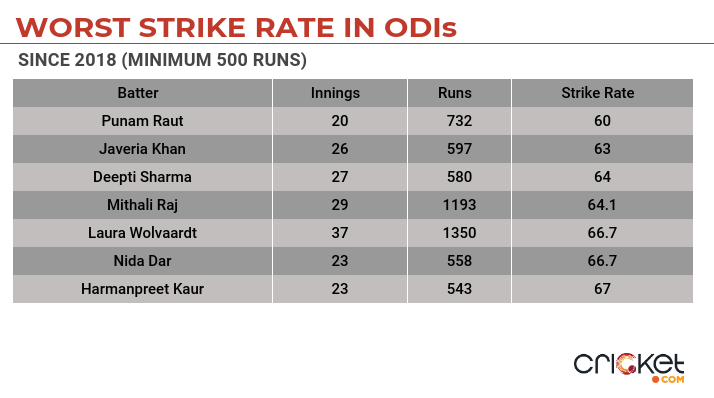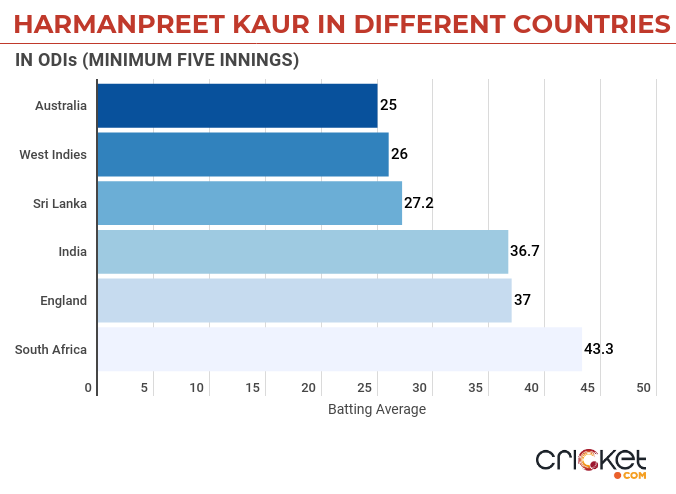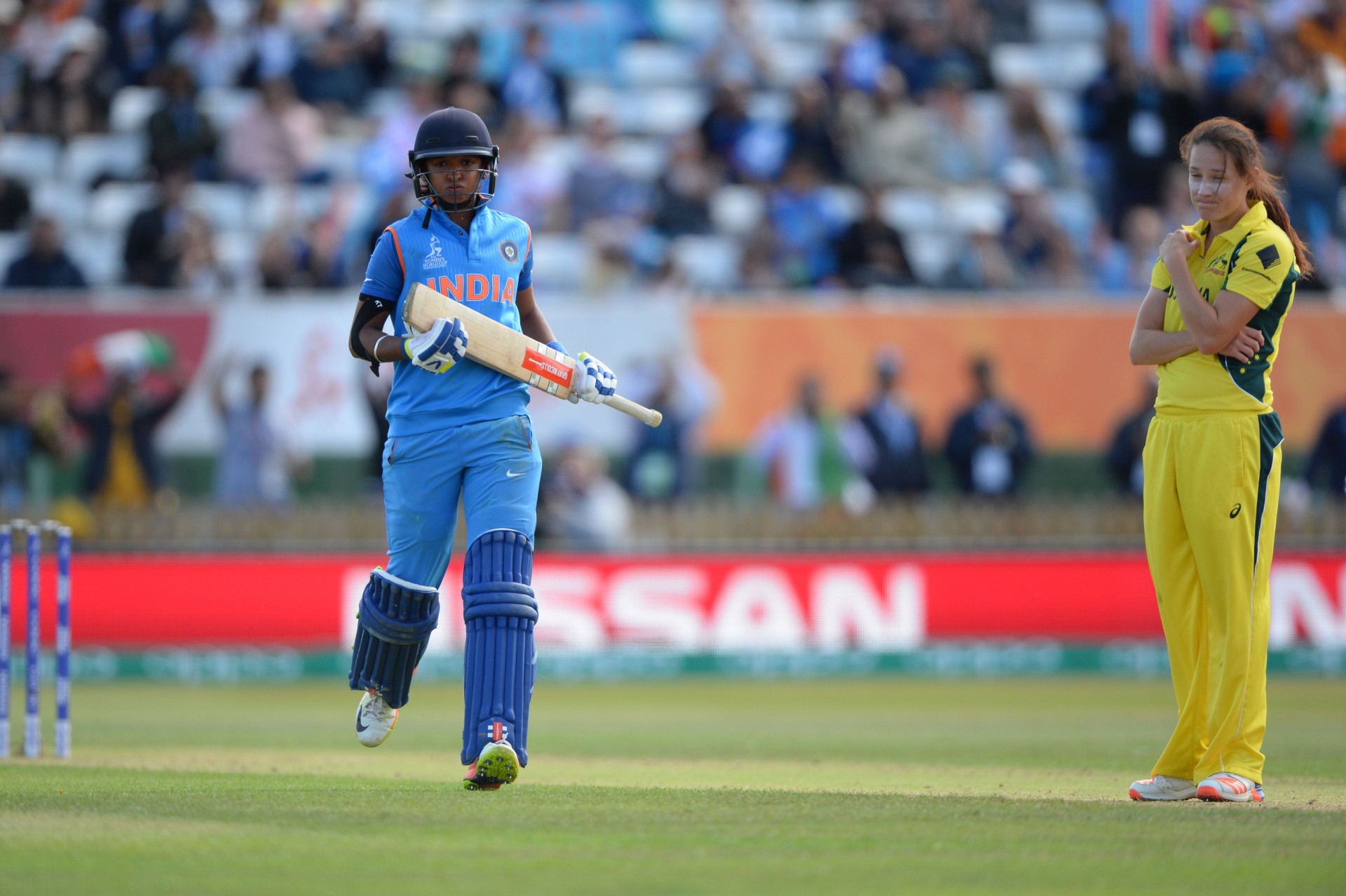 OPINION
OPINIONHarmanpreet Kaur's inconsistency with the bat is exasperating! The middle-order batter’s 171* against Australia in the semifinal of the 2017 World Cup and 103 against New Zealand in the 2018 T20 World Cup changed the face of women’s cricket in India, but the 32-year-old hasn’t done much since then. There have been glimpses of brilliance but Harmanpreet has failed to live up to her standards in these last two-three years.
The next 50-over World Cup is just six months away and India desperately need the 2017 version of Harmanpreet if they want to compete with the likes of Australia, England, and South Africa. The Women in Blue have a middle-order comprising Punam Raut, Mithali Raj, Deepti Sharma, Jemimah Rodrigues, and Harmanpreet and none of these batters have a strike rate of more than 70 in ODIs since 2018. India are scheduled to play a three-match ODI series against Australia, starting Tuesday (September 21), and they couldn’t have asked for a better opponent to get themselves ready for the upcoming showpiece event in New Zealand.
Too slow for her own good
India have got two fearsome openers in Smriti Mandhana and Shafali Verma but their middle-order lacks firepower. Amongst teams who have played at least 10 ODIs since 2018, India (4.4) have the fourth-worst scoring rate and that’s largely because of their middle-order. Meanwhile, Australia have a scoring rate of 5.6 in this same period. Raj, Raut and Deepti have a strike rate of less than 65 in ODIs since 2018, and Harmanpreet, who is unarguably India’s cleanest striker in the middle-order, operates at just 68.3.

Amongst batters who have scored at least 500 runs in this period, Harmanpreet has the seventh-worst strike rate. Meanwhile, the other aforementioned three are even worse, which does India no good against quality opponents. Now, if you compare them with other batters from Australia and England, the likes of Alyssa Healy (106.2), Danielle Wyatt (90.9), Beth Mooney (89.2), Ashleigh Gardner (104), Meg Lanning (87.4), Heather Knight (84.9), Natalie Sciver (83.1) and few others are on a different league.
On paper, if there’s one Indian middle-order batter who could match them, it’s Harmanpreet. In 2017, the right-hander from Punjab slammed 505 runs in 15 innings at an average of 50.5 and a strike rate of 84.3, but these numbers have gone down drastically in the last three years. From 2015 to 2017, Harmanpreet scored a boundary every 11.3 deliveries but that has gone up to 13.5 since 2018. She has only managed two-50 plus scores since 2018 and both of those fifties came against South Africa. In 10 of her last 23 innings, she has crossed the 20-run mark but hasn’t been able to convert it into a half-century.

If you look at the above table, Harmanpreet has better numbers batting at No. 5 than at 4. But, with Raut and Raj batting above Harmanpreet, it only puts more pressure on the 32-year-old. In short, India can’t afford to play both Raut and Raj in the same XI. Harmanpreet has done well at No. 4 in the past and the team management could bring in someone like Richa Ghosh at No. 5 who is a natural stroke-maker. Harmanpreet did find some form in The Hundred before she was injured and the forthcoming ODIs against the top-ranked team will give her a perfect platform to return back to her best, but her record in Australia is not so convincing.

Consistently inconsistent
There is no denying that Harmanpreet is a match-winner but the right-hander has been very inconsistent. From 2012 to 2014, Harmanpreet scored 919 runs in 26 innings at an average of 41.77 but struggled big time in the next two years. She was outstanding in 2017 but things haven’t gone right since the 2017 World Cup. It’s not just the 50-over format, Harmanpreet averages less than 20 and has a strike rate of just 100 in T20Is since 2019.
Amongst batters who have scored at least 1000 runs in ODIs since 2015, Harmanpreet has the second-least 50-plus scores. South African all-rounder Marizanne Kapp has only managed five fifties in this time period, while Harmanpreet has the same number of half-centuries and one hundred. In total, she only has six 50-plus scores in 63 ODIs. Some of the other middle-order batters like Ellyse Perry (20), Sciver (20), Dane van Niekerk (9), and many more have been far more consistent than Harmanpreet.

At the age of 32, Harmanpreet should be at the pick of her career but the right-hander is still struggling for consistency. Out of 11 players who have batted at least 10 times either at No. 4 or 5 in ODIs since 2018, Harmanpreet has the worst batting average. As a matter of fact, she is the only one averaging less than 30 in this period. She also has the third-worst strike rate among them. The next few months are going to be crucial for Harmanpreet and the Indian team management would want their senior batter to be a lot more consistent if they want to take on the likes of Australia and England.
"I do watch videos of matches where I have performed well, whether it was a long innings or a cameo in a winning cause. Such innings you feel like watching several times over because they always motivate you to perform better and they boost your confidence. I'm someone who works every day and I have realised this time (during this tour) that you have to figure out ways yourself to get the best out of yourself when you don't have enough time to prepare,” Harmanpreet said during the England tour.
The Women in Blue have got their opening combination sorted but they desperately need Harmanpreet to take care of the second half of the innings. The senior batter spoke about watching old videos of games where she did well and all she has to do is to go back and watch what she did against Australia on July 20, 2017. That 115-ball 171* was a once-in-a-lifetime knock, but even if she could create 70-80 percent of the impact on a more regular basis, it would do India a lot of good.